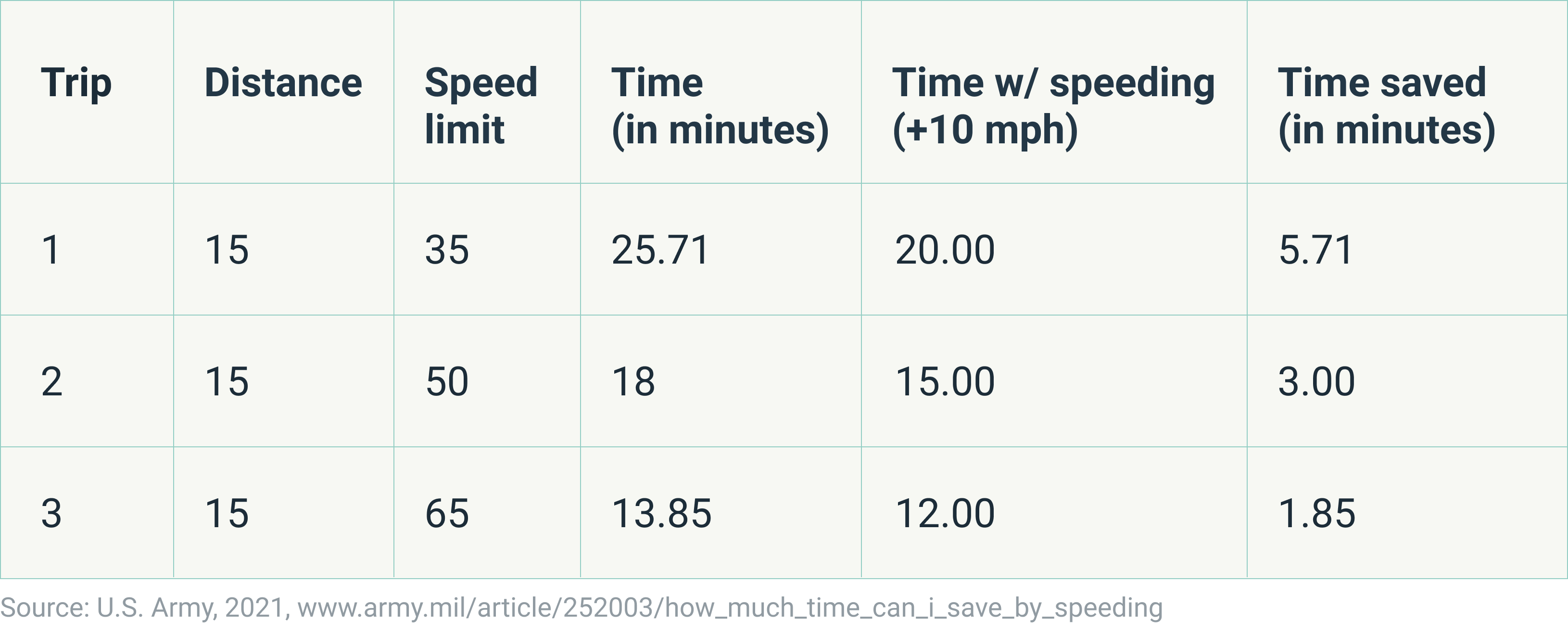How much time does speeding actually save?
August 4, 2022
As a regular commuter who’s
mindful of their driving habits, chances are you’ve experienced someone on the road drive recklessly through lane swerving, tailgating and speeding—only to find them right next to you at the stoplight.“Did they actually save any time driving like that?” may cross your mind. And for a good reason. Let’s dive into
why folks feel the need to speed and the dangers of speeding.Why are we inclined to speed?
Life in the fast lane isn’t all that it’s cracked up to be. Yet, some of us have an adherent desire to go too fast on the road and drive a little less mindfully. There’s a psychology to speeding, and we’re going to go a little deeper to understand what motivates someone to speed.
Speaking on NPR’s Talk of the Nation, Leon James, a psychology professor at the University of Hawaii, mentions that folks are inclined to speed because we don’t call it speeding. We aren’t defining it. Is it breaking the speed limit? According to James, people simplify their own definition of speeding as going over posted limits by 20 or 25 mph. They’ve realized that, legally, they’re breaking the speed limit and have assumed that they’re not causing harm by driving above the speed limit.
“We need to remember that the word speeding is a kind of a buzzword—what does it exactly mean?”
– Professor Leon James
In a way, it feels almost natural to drive over the speed limit. It feels okay to do because you might be “just going with the flow of traffic.” Yet, has the practice of speeding become a learned behavior that we’ve grown to accept as normal?
James highlights that we are often taught to speed based on our culture. It’s a habit and a way we usually feel about ourselves—we tend to want things done quickly. So in many ways, it can feel natural and harmless to go over the speed limit, and it is seen as unnatural to experience a commuter who is driving at the speed limit.
There’s an immediacy that we have become accustomed to as a society, but the question remains—is speeding actually saving you time?
Are we actually saving time when we speed?
Whether we’re late for that morning meeting or speeding is the result of impatience—many are obsessed with speeding. We love the idea that we are made for living life in the fast lane. Because why wouldn’t we go faster if it meant we’d get to our destination much more quickly?
Here’s our take: you aren’t saving that much time by speeding.
In a study conducted by the U.S. Army, several scenarios outlined different trip lengths (15, 30, 50 and 200 miles). Each trip was measured at different speed limits (35, 50 and 65 mph) and subsequently showed how long those same trips would take at 10 and 20 mph above those limits.
Their study says that in the U.S., the average one-way commute is 15 miles. Without consideration for traffic signals or traffic, they developed a chart to show how much time you’d save at each speed limit of 35, 50 and 65 mph, if you were traveling 15 miles and speeding at 10 miles over the speed limit.

Less than six minutes—that’s how much time you may only be saving on a commute that is already less than a half hour. An interesting takeaway from their study is that the higher the speed limit is, the less time you save by speeding. They explain this point further in their study with a scenario:
If you’re going 45 mph and the speed limit is 35, you’re traveling around 30 percent faster than the posted speed limit (around six minutes saved). If the speed limit is 65 mph and you’re going 75 mph, that’s only about a 15 percent increase (about two minutes saved)—even though in both scenarios, you’re going 10 mph over the speed limit.
Are those six minutes worth it? It’s time to think about the dangers of speeding and the consequences of reckless behavior behind the wheel.
The dangers of speeding
Many drivers are in denial about our speeding behaviors. They see speeding as harmless, which can cause some pretty big issues. With speed limits being one of the most disobeyed laws in the U.S., speeding was responsible for 29 percent of all traffic fatalities in 2020, according to the National Safety Council. That percentage translates to 11,258 speed-related road fatalities in the same year.
To put that into perspective, that is an average of over 30 people per day.
We understand that life can get busy and the frustrations of modern life can leave us wanting to go fast behind the wheel, but the dangers of spending aren’t something to take lightly. Speeding goes beyond the scope of breaking the law. If someone is speeding, not only are they endangering themself but those around them as well. The National Highway Traffic Safety Administration shares the dangers and consequences of speeding as follows:
Higher risk of losing control of the vehicle
Reduced effectiveness protection equipment
Increased stopping distance
Higher crash severity
Increased fuel consumption
With those dangers of speeding in mind, say you’re a mindful driver, pedestrian or bicyclist affected by other people speeding on the road. What do you do?
First and foremost, use the left lane and allow others to pass. It’s not your role or responsibility to confront an aggressive driver on the road. Give those who are speeding—space.
Slow(er) and steady wins the race
Speeding and driving recklessly isn’t all what it’s made to be. As an insurance company, we’ll mention that speeding citations or accidents that result from speeding can affect your insurance rate and/or ability to find car insurance because often, your Motor Vehicle Report (MVR) will show your driving record history. In addition, an MVR can help insurers evaluate the risk of existing or new policyholders to determine eligibility and rate.
What can help contribute to a safer drive and potentially great car insurance rate? Going the speed limit. At HiRoad, we reward you for that. Through telematics and the powers found within your mobile device, we use the technology in your phone to power an app that gives you insight into how you’re driving.
When you’re traveling at Safe Speeds, you’re taking the high road and deserve to be rewarded for that—especially when that reward comes in the form of savings (up to 50%* on your monthly bill when you are driving mindfully).
So take things slow and enjoy the road ahead.
The information in this article was obtained from various sources not associated with HiRoad®. While we believe it to be reliable and accurate, we do not warrant the accuracy or reliability of the information. HiRoad is not responsible for, and does not endorse or approve, either implicitly or explicitly, the content of any third party sites that might be hyperlinked from this page. The information is not intended to replace manuals, instructions or information provided by a manufacturer or the advice of a qualified professional, or to affect coverage under any applicable insurance policy. These suggestions are not a complete list of every loss control measure. HiRoad makes no guarantees of results from use of this information.
*The discount applies to the variable portion of your premium. A fixed expense is added to that to determine your final premium.
Stay on the path
Get HiRoad in your inbox
Share your email to get the latest about our community of mindful drivers.



